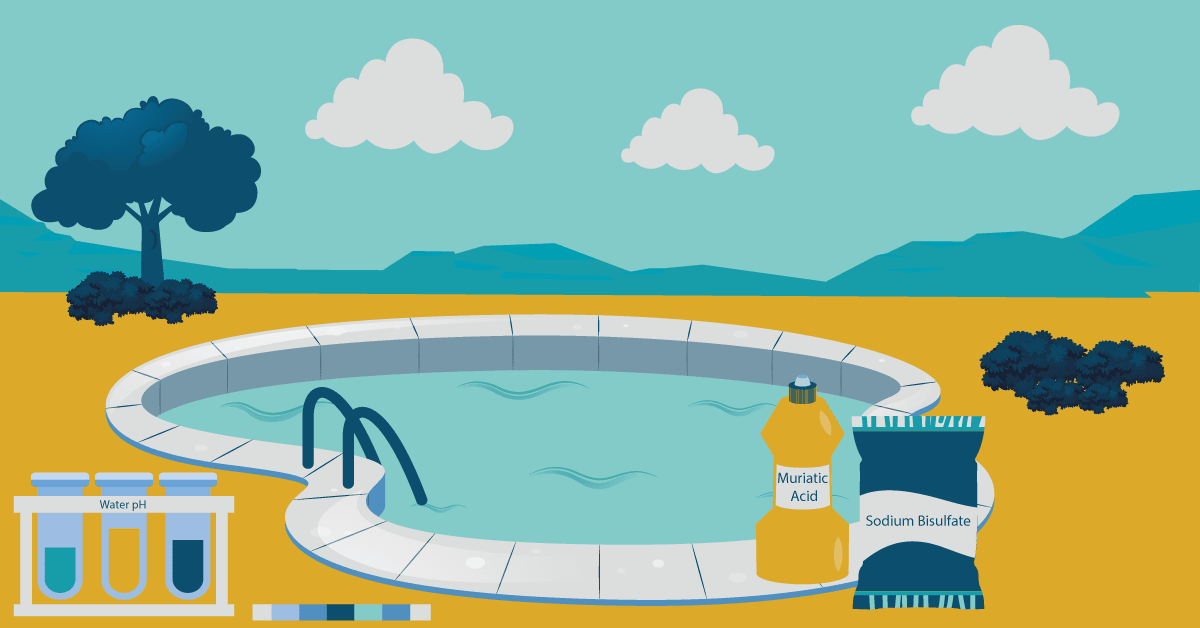Pools need a lot of maintenance and not just the pool chlorine levels. It’s important to know how to lower pH in pool to ensure its levels are safe for the pool and the swimmers in the pool.
Not sure how to lower your pool’s pH? Continue reading to learn more about pool chemistry and how to ensure your water’s ph levels are properly balanced.
What Is Pool Water pH?
A pool’s ph is a measurement of its acidity. It’s measured in a range of 0 to 14. Pool water is typically between a pool pH of 7.0 and 8.0. A pool with a 7.0 pH is acidic. A pool with a pH of 8.0 is alkaline.
Most pool water falls somewhere in between 7 and 8. Ideally, pool water should have a pH balance of 7.4 to 7.6. If your pool’s pH is any higher, you need to know how to lower the pH in the pool.
What Causes High pH in the Pool?
Sometimes a pool’s pH balance rises temporarily and that’s okay. If your pool water is consistently on the high end, you need to know why.
Here are a few common reasons:
- Your City’s Water Is Very Acidic. Most public water supplies are acidic rather than alkaline because high alkalinity would cause the pipes and systems to corrode faster.
- You Used Too Much pH Increase. It’s easy to get overzealous with the pool chemicals. Watch how much increase you use to avoid increasing it too much.
- You Added Too Much Chlorine Stabilizer. While it’s an important pool chemical, overuse can cause your pH levels to increase.
- A Quick Increase in Temperatures. If your swimming pool water temperature suddenly increases too fast, it can cause the current pH level to increase quickly.
Effects of a High pH Pool
High pH pool water can cause devastating effects to the pool, your skin, and anything you wear. This happens because the water gets too soft. That may sound like a good thing, but it’s not. Here’s what may happen:
Your skin may become irritated.
Your eyes may become red.
Your swimwear, goggles, pool ladders, pool vacuum, pool pumps, pool filters, pool-heating elements, and pool accessories may get damaged.
Your pool equipment may have scaling, which decreases its effectiveness and cause excessive wear and tear
If your water chemistry isn’t properly managed, it can become corrosive to your home pool. Pool liners and even fiberglass can begin to ruin.
How to Lower pH in Pool (2 Ways)
It’s important to focus on your pool’s pH level as soon as you know it’s below 7.6. There are two main chemicals used to reduce your pH levels: sodium bisulfate and muriatic acid.
Your first step is to measure the pH level. If it’s above 7.6, it’s time to try one or more of the following:
Sodium Bisulfate (Dry Acid)
Sodium bisulfate, also known as dry acid, is a great way to lower your pool’s pH. It comes in a powder form and is a mild solution that is a good starting point before trying something more drastic.
Read the instructions on the label and use 75% of what they recommend to start. You can always add more, but you can’t take away what you already used. It’s best to do this on a non-windy day as the fine powder can easily blow away and be less effective as it’s hard to measure how much is made in the pool.
After 10 minutes, the acid dissolves on its own. Let it sit for at least six hours before water testing.
Please note – Dry acid affects not only the pool’s pH, but it’s total alkalinity too. Consider retesting the water within 24 hours, and check both the pH level and alkalinity.
Muriatic Acid
Muriatic acid or hydrochloric acid has many more uses than lowering a pool’s pH level. Its other uses include acid washing tiles and dissolving rock, which shows you just how strong it is. Use caution when using muriatic acid.
Unlike sodium bisulfate, muriatic acid is a liquid, but you should still use caution using it in the wind. Read the manufacturer’s instructions carefully, determining how much to use. Again, we suggest using 75% of the amount they recommend. You can always add more if needed.
Make sure you pay careful attention to whether the acid should be diluted or not. Then choose one of two methods to apply it:
- Turn Off the Pool Pump – This method assumes the acid will go straight to the bottom of the pool if you turn the pump off and let the water be still for at least one hour. Pour the acid in a steady stream so it goes straight to the bottom of the pool. Let the acid sit for an hour and then turn on the pump and let the acid work throughout the pool, lowering the pH level. The idea behind this is to avoid affecting the pool’s alkalinity level as dry acid does, as there is less alkalinity at the bottom of the pool.
- Spread the Acid – If you don’t want to turn the pool’s pump off, you can spread the acid by pouring it in the deepest end of the pool near the water return. Pour the acid as close to the water as possible to avoid getting it on any pool equipment (it could damage it). Make sure you make circular motions with the liquid as you pour it in – don’t concentrate in one area. Let the acid disperse throughout the pool – testing it after at least six hours.
Use caution when you add muriatic acid. Protect your skin and your eyes as it can burn. We suggest you use proper eye protection and wear protective clothing. Have a hose ready to blast any area you get acid on as it will burn intensely. Also, protect all areas around the pool – the acid will instantly ruin concrete, masonry, and pool surfaces.
Pool pH Too High? 5 Pool Maintenance Tips
Keeping your swimming pools pH balanced is important. Once you know it’s high, your pool requires regular maintenance to keep its levels low. Try the following:
- Test the pool daily until you regularly have the pH levels under control
- Once you have the pH levels under control, test it twice a week
- Regularly use a pool skimmer to keep leaves and debris out of the pool as even small debris can affect the pH level
- Keep the filtration system clean because with a clean system, your water will have a naturally balancing pH level
- Chlorine shock treatment your pool as often as needed (at least once a month, but sometimes more often is better)
FAQs on How to Lower Pool pH
How to Lower PH in the Pool Naturally Without Chemicals?
Lowering your pool’s pH level usually requires the use of chemicals, but there are a few ways to do it naturally:
-Use distilled water (which you’d have to get from your house)
-Use a pool heater, as warmer water naturally dissolves substances faster, which may help the pool’s pH level
-Don’t change the water – the more you change the water the more the pH level is affected
Does Chlorine Raise or Lower PH Levels?
High chlorine levels may cause lower pH levels, but it always makes it more acidic. The higher the level of acidity, the more corrosion occurs in a pool. Corrosion ruins a pool’s equipment and even the surface of the pool.
Is It Safe to Swim in a Pool With a High PH Level?
Pool safety is always a concern. Pools with a high pH may cause eye and skin irritation. High pH levels also decrease the chlorine’s effectiveness, which may make it unsafe to swim in.
Does Shocking a Pool Lower the Pool’s PH?
Shocking a pool with a chlorine based shock increases the pool’s pH. Shocking a pool with a chlorine-free pool shock doesn’t affect the pool’s pH.
The Bottom Line: Lowering pH in Pool
Learning to maintain a pool can be difficult. Understanding how adding chemicals affects several water-level chemical balance measurements is a necessity. If you don’t have the time to dedicate to understanding the various swimming pool chemicals required, consider hiring a pool care professional.
It’s important to keep your pool’s pH between 7.4 to 7.6. If your pool’s pH is too high, learn how to lower the swimming pool pH level quickly. High pH levels can cause damage to your pool and even the swimmers, causing serious and painful damage.

For over 15 years, Sean Moore has been sharing his love and enthusiasm for swimming pools and hot tubs with everyone he knows. His goal is to help everyday people DIY their maintenance to save money by teaching how to properly take care of your equipment, safely and correctly balance chemicals, and extend the life of your water oasis.


